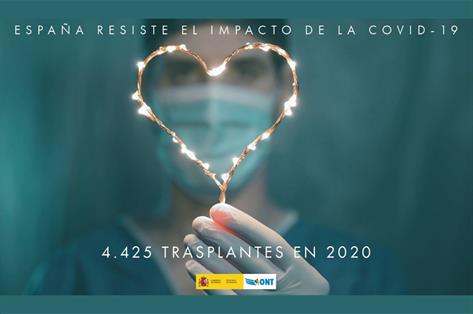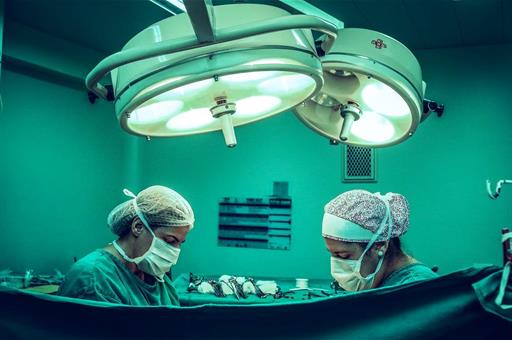Spanish National Transplant Organisation presents its balance of activity in 2020
Spain resists impact of COVID-19: 4,425 transplants performed in 2020
News - 2021.1.18
Despite many difficulties, over the course of last year 4,425 organ transplants were performed in our country, which corresponds to a rate of 93.3 per million population. This activity was possible thanks to the 1,777 people who donated their organs to be used after dying, which places us at 37.4 donors p.m.p. and the 268 live donors of a kidney or part of their liver. Compared with 2019, the fall in transplant activity has managed to be reduced to only 18.8%, thanks to the involvement of the network's professionals and the solidarity of Spanish society, while donations fell by 22.8%.
It is important to highlight, despite being in mid-health crisis, that Spain's donation rate is much higher than other countries even in the "pre-pandemic" period. Accordingly, in 2019, Germany recorded 11.3 p.m.p., Australia 21.8, Canada 22.2, France 29.4, Italy 25.3, the United States 36.1, the United Kingdom 24.7 and the European Union average stood at 22.5 donors p.m.p. According to the figures from the National Transplant Organisation (Spanish acronym: ONT), in 2020, 2.700 kidney transplants were performed, 1,034 liver transplants, 336 lung transplants, 278 heart transplants, 73 pancreas transplants and four intestine transplants. The activity of live donor transplants was also maintained, with a total of 257 kidney transplants and 11 liver transplants.
The figures were announced on Monday morning by the State Secretary for Health, Silvia Calzón, at a press briefing held at the headquarters of the Ministry of Health, where she was accompanied by the Director-General of the ONT, Beatriz Domínguez-Gil. Silvia Calzón highlighted "the strength of the Spanish Transplant System at an adverse time. Despite the rate of activity falling, we remain a benchmark on the international stage".
Tackle COVID-19 and protect activity
The State Secretary for Health pointed out that the fall in activity primarily took place during the first wave of COVID-19, between the months of March and May 2020. Until that time, donation and transplant had continued on an upward curve, showing the efficacy of the measures under the '50x22' Strategic Plan of the ONT. This plan seeks to achieve 50 donors p.m.p. and exceed 5,500 transplants a year by 2022, something that we would probably have achieved in 2020 had it not been for COVID-19.
However, the pandemic caused the saturation of the health system and of Intensive Care Units (ICUs), which were overwhelmed by patients with COVID-19. "We should not forget that only 1% to 2% of people who die in a hospital do so in a condition to be a donor and they do this in ICUs - units that have been saturated, above all at the most critical times of the epidemic" - clarified the State secretary. A second reason that explains the drop in activity is related to patient safety and the concern over the impact that the COVID-19 infection could have on transplant recipients.
The adoption of a series of measures by the Transplant System led to the gradual recovery of the programme, such that the monthly rate of donations and transplants from June to December 2020 has got close to the figures recorded in the same months of 2019. For the State Secretary for Health, "this evolution clearly shows, one again, the capacity of the Spanish Donation and Transplant System to quickly adapt to unfavourable environments. This is on top of its extraordinary contribution to social cohesion, which is so necessary in our society and which we should look after well".
Specific reconstruction plan
 Subsequently, the Director-General of the ONT, Beatriz Domínguez-Gil, explained that "there have been three pillars to the reconstruction programme, addressed in a specific plan designed by the ONT and the Regional Transplant Coordination Units, in collaboration with the scientific societies involved, with the aim of maintaining this essential activity of our National Health System and of guaranteeing the safety of patients and professionals".
Subsequently, the Director-General of the ONT, Beatriz Domínguez-Gil, explained that "there have been three pillars to the reconstruction programme, addressed in a specific plan designed by the ONT and the Regional Transplant Coordination Units, in collaboration with the scientific societies involved, with the aim of maintaining this essential activity of our National Health System and of guaranteeing the safety of patients and professionals".
The ONT has issued recommendations, periodically updated, on the evaluation of potential donors and recipients regarding COVID-19 and developed procedures to facilitate the logistics of the processes. It has also generated evidence on the impact of the infection in transplant patients, with conclusions that have helped manage the programmes.
At the most complicated times of the health crisis, transplants of patients with status 0 or in a very serious clinical situation have been prioritised, where a transplant cannot wait, together with patients on whom it is difficult to perform a transplant due to their immunological characteristics or size. In this regard, there were a noteworthy 219 transplants for patients with status 0, 103 hyper-immunised kidney transplant patients, thanks to the ONT's PATHI Programme (Spanish Prioritisation System for Highly Sensitised Patients) and 197 children.
One figure that precisely shows the dynamic nature of our system is that these 197 transplants for children, a paediatric activity record in the ONT's history, and one of the goals contained in the '50x22' Strategic Plan, with measures to improve access to children needing a transplant, is now proving successful.
Despite last year's significant transplant activity, a large number of patients still remain on the waiting list for an organ. As at 31 December 2020, this figure stood at 4,794 patients, of which 92 are children. The number of patients on the list is slightly lower than in 2019 (4,889 patients). This decline is primarily due to a reduction in the number of patients included on the waiting list for a transplant in 2020, which can be attributed to the saturation of the health system due to COVID-19.
Donor profile
Asystolic donation is consolidating its position as the clearest way to increase the number of transplants, with a total of 621 donors. At present, the organs of 35% of donors are removed after circulatory death; i.e. one in three. More than 120 hospitals throughout the country are already accredited to perform this type of organ donation.
Donors dying in road traffic accidents account for 4.5% of the total, one of the lowest percentages in the last decade. The main cause of death of donors is a stroke.
In terms of donor age, more than half (54.1%) are over 60; 28% are over 70 and 5.4% are over 80. The oldest age for an effective donor stands at 90, which enabled a liver and two kidney transplants to be performed.
Objections from relatives stand at 14%. This percentage falls to 10% in the case of donors after circulatory death.
Data by autonomous region
Nine autonomous regions posted a figure of more than 40 donors p.m.p. while five posted a figure of more than 50 p.m.p.
Cantabria again leads the table with a rate of 65.5 donors p.m.p. This region was followed by Navarre (53), the Canary Islands (51.6), the Basque Country (51.4) and Murcia (51).
Due to the tremendous difficulties they have had to face, it is very significant that three autonomous regions managed to exceed the number of donors year-on-year in 2020: La Rioja (up 16.7%), Navarre (up 2.9%) and the Canary Islands (up 2.8%).
Furthermore, the ONT states that 1,200 patients received a transplant thanks to the exchange of organs between the regions of Spain, accounting for 27.8% of the total. In turn, 8.1% of transplant recipients received an organ from outside of the autonomous region where they reside. These two figures highlight the cohesive nature of the Spanish Transplant System.
Activity by hospital
The centres that have posted the most activity in 2020 are as follows:
Other outstanding achievements in 2020
• In conjunction with Portugal, Spain performed the third international crossed kidney transplant in southern Europe at the height of the pandemic, in a complicated operation coordinated by the ONT and involving the participation of the Puigvert Foundation of Barcelona and the Porto University Hospital Centre.
• The Heart Transplant Programme from Asystolic Donation in Spain was initiated, with an innovative procedure based on the use of extracorporeal membrane oxygenation (ECMO). Four heart transplants from asystolic donation were performed in 2020. The first at Puerta de Hierro University Hospital in Madrid, two at the Virgen de la Arrixaca University Hospital in Murcia and the fourth at the Marqués de Valdecilla University Hospital in Santander.
• After launching the incompatible AB0 child heart transplant programme in 2018, eight such transplants have now been performed in Spain. The two latest operations were performed at the Vall d'Hebrón University Hospital in Barcelona and at the Gregorio Marañón University Hospital in Madrid.
• The La Paz University Hospital performed the first combined multivisceral and haematopoietic progenitor transplant from the same donor, with the logistical support of the ONT.
• Despite the pandemic, the ONT coordination team recorded some days of very intense activity. The most recent was on 18 December when 13 donors were notified that involved 17 hospitals in seven different autonomous regions.
National Bone Marrow Plan
As at 1 January 2021, Spain has a total of 439,350 bone marrow donors registered with the Spanish Register of Bone Marrow Donors (Spanish acronym: REDMO). Of those, 29,365 are donors who registered in 2020, despite the difficult health situation we were going through.
At the worst point of the pandemic, the ONT and the REDMO set in motion an extraordinary procedure so that haematopoietic progenitors (bone marrow or peripheral blood) transported from other countries could arrive in our country in time and with all due guarantees to carry out the scheduled transplants.
Non official translation





